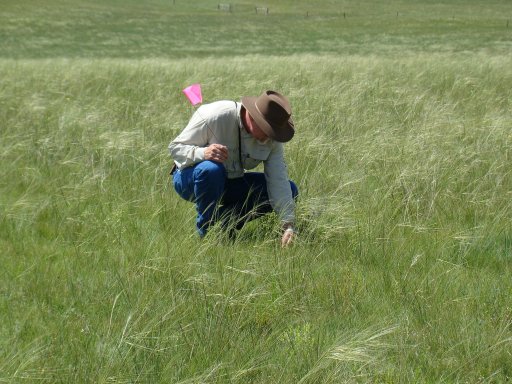
By Cindy Tusler, UNL Extension Educator
Two big questions weigh on ranchers’ minds every year, but especially during droughts: When is the moisture going to come, and how much?
Drought response planning is standard operating procedure for ranchers in the Panhandle, where drought is a normal part of the climate. But it’s more important than ever in 2013. As the area enters its second year of below average moisture, having and using a written drought management plan to mitigate the impact on grazing lands is key for 2013 and also for long-term forage production.
While most droughts are relatively short-term events, how a rancher responds can influence their long-term impact on the ranch and its forage resource.
Many ranchers started the year with pastures that are already depleted. The severe drought during the 2012 growing season caused plants to enter the fall in low vigor. And many areas are very low in soil moisture.
These events have combined to leave key forage plants in many pastures unable to produce typical amounts of forage in 2013. Even if rainfall is near average between now and June, when the Panhandle typically receives 25 to 30 percent of the annual moisture, initial stocking rates going into the 2013 growing season should be reduced by about 20-25 percent from typical rates.
According to the long-term forecast on the Drought Monitor website (http://droughtmonitor.unl.edu), the probability is low of receiving precipitation amounts in 2013 near the long-term averages.
It will be important to monitor the amount of moisture received on the ranch and make additional stocking decisions. To help decide whether additional stocking rates should be reduced further, many use a critical date or a “trigger date.” If moisture has not reached a certain level by each trigger date, this triggers a stepwise reduction in stocking rates by a certain amount.
Trigger dates are developed based on a ranch’s soils and mix of plant species. The dates vary depending on key forage types, such as cool-season or warm-season dominated pastures, soils type, and other factors. Knowledge of these key times, coupled with on-ranch precipitation records, can help ranchers make stocking decisions early to avoid overgrazing.
In the Nebraska Sandhills, where warm-season grasses dominate, precipitation during May, June, and July correlate best with seasonal forage production. In mixed-grass environments, which are cool-season dominated plant communities and more common to other parts of the Nebraska Panhandle, research shows that April, May, and June precipitation is the best predictor of current year production. There is not a single plan that works for every operation, but steps can be taken to significantly reduce farm and ranch vulnerability to drought. Try to avoid rigid plans that require moving animals from one pasture to another on given dates.
Other environmental factors certainly will influence grass growth and use at any point in time. Base decisions to move stock on how and when the grasses are used and how much green leaf material remains, not on a predetermined date.
A main focus of all grazing management will be to not graze the same pasture at the same time of year, year after year.
Some key trigger dates for western Nebraska for cool and warm season dominated pastures are:
• Look at the previous year’s growing conditions and reduce stocking demands prior to spring green up. Following the extreme drought of 2012, much of the Panhandle went into the winter with very little residual forage and very low soil moisture. Given this did not set our pastures up well for the 2013 growing year, stocking demands for 2013 should already be down by about 15-20%.
• April 1. If precipitation is less than about 65% of the long-term average for the October through April period, ranchers should probably consider an additional 10-15% reduction in stocking demands for 2013 grazing season.
• Mid April to May 1. Usually by this time, moisture and temperature prediction models are fairly accurate at indicating the type of weather expected for the next 1-2 months. If the models call for above average temperatures and near average rainfall, additional livestock reductions should be considered or use of alternative forage resources need to be set in place.
• Late May to June 1. If moisture for the March through May period was around 50-75% of our long-term average for that window, further reductions should be considered and could be in the range of an additional 10-30%.
• Mid to late June. By this time in our cool season pastures about 75 – 90% of all plant growth for the current year has occurred, very little forage accumulation will happen after this date. Rainfall after this date is important for soil moisture status and to set up the pastures for the 2014 growing season but will not grow 2013 grass. In warm season pastures (Sandhills) about 50% of the current year’s production has occurred by the middle of June.
Some useful on-line resources that will help ranchers set trigger dates and make stocking decisions:
• Skillful Grazing Management on Semiarid Rangelands: This publication describes grazing forages reproduction, the growth patterns of plant parts, and managing grazing and drought conditions. On-line at http://www.ianrpubs.unl.edu/sendIt/ec162.pdf
• Nebraska Drought Resources. On-line at http://droughtresources.unl.edu/
For more UNL Beef information go to http://beef.unl.edu